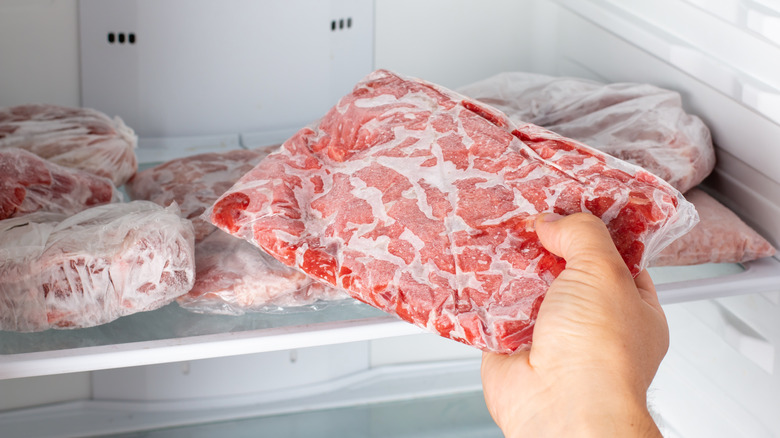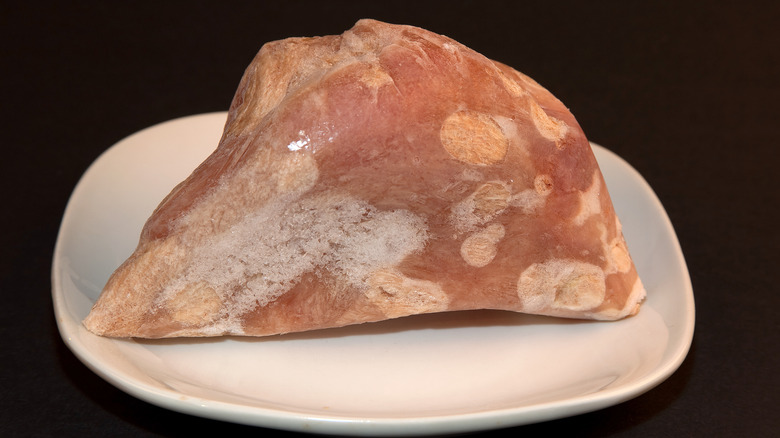You Should Think Twice Before Eating That 2-Year-Old Frozen Meat
Seeing a major deal on something like beef brisket at the grocery store can get your heart pounding. You might not want to cook it right away, but that's fine because you can freeze it and pull it out (basically) whenever you're ready to prepare it. You exit the grocery store feeling like you just won the lottery, and as soon as you get home, you put that gorgeous roast into the freezer and admire it for a moment before you go about the rest of your day.
Fast forward a couple of years — you're looking through the freezer for something to prepare your next meal, and you glance at that brisket in the corner you completely forgot about. As you pull it out of the freezer, it dawns on you exactly how long this forgotten treasure has been hidden from view, and you (understandably) wonder if it's still any good. The answer depends on what you define as "good."
If you are referring to whether or not it is safe to consume, then the answer would be yes, that brisket is perfectly okay to eat. But that doesn't mean it is going to taste great. When food sits in a freezer, its condition degrades over time as moisture escapes. Even vacuum-sealed frozen meat isn't completely protected from degradation over time. Frozen meat will survive the freezer for quite a while without losing quality, but not forever.
How long until meat loses quality?
Frozen meat can last for months, depending on the variety. Fish, for example, like salmon, halibut, and pollock, retain their quality for between 2 and 4 months, while squid and shrimp are good for 18 months. Ground beef lasts 3 to 4 months in a frozen state before degrading. Whole cuts of meat, such as steaks, roasts, and turkey, can be frozen for up to a year without any loss in quality.
Vacuum sealing with freezer-safe bags is a great way to store frozen meat, but if you don't have a vacuum sealer lying around, a freezer bag will also work. Just avoid sandwich bags because they can break when frozen and become punctured. One trick to help you remember how long food has been frozen is to attach a piece of masking tape to the bag and label it with the date it gets put in storage, and, based on this info, the date you should use it.
Frozen meat sits in a freezer and eventually becomes exposed to the air, which causes oxidation. Before oxidation, beef is a deep reddish-purple color, but it starts to develop a bright red and then brown color the longer it is exposed to oxygen. Other meats, like poultry, can also experience discoloration from oxidation, but the change may not be as obvious as beef. Brown beef isn't necessarily spoiled, but it does warrant a deeper inspection.
Signs you should throw it out
If you're pulling out a roast from the back of the freezer and raising an eyebrow as you look it over, here's what you can keep in mind. Discolored parts can usually be removed to reveal satisfactory meat below the cut. It's also a good idea to examine the meat by touch. Any slimy or mushy texture with a thawed piece is a sign the meat has spoiled. The tried-and-true way to tell if meat has gone bad is to give it the smell test. If something has a rancid or abnormal odor, it has failed and should be discarded. Remember — when in doubt, throw it out.
If you've labeled your frozen meat with a date of storage, it's easy to take a look in the freezer once a week and rotate what is inside. You can utilize the first in, first out (FIFO) method to rotate your frozen products the same way restaurants do. Look at the dates on your frozen foods and move the ones with the oldest date to the front of the freezer. This way, that brisket that made you feel like it was your lucky day will have its time in the oven before it becomes a reminder that it's probably about time to deep-clean the freezer.


